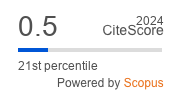The Prevalence and Evaluation of Electronics Incorporated Into the Educational and Recreational Activity of Schoolchildren of 7–8 Classes
Abstract
The widespread use of new information technologies in education leads to ad hoc use of modern electronic devices, to the problem of health security in the use of information technology. Visual impairment in children are among the most important medical and social problems of modern society. Research proven rapid increase from 1-st to the 7-th class of the prevalence of myopia among schoolchildren with a tendency to vision to 0,5 diopters each year. The aim of the study was to identify the preferences of teenagers of electronic devices and to study the eff ect of the use of electronic devices in educational and leisure time activities of 7–8 grade students with the complaints. Medico-social survey of pupils of 7–8 classes defi ned the «rating» of electronic devices for children, used not only as a means of communication, but also to access the Web, leisure (97,5% of the respondents have daily) tablets is used daily by 51,6% of pupils. Complaints about health at work with a gadget note from 7,8% to 40,2%. Analysis of the respondent’s ailments has revealed the lead complaints of eye fatigue. Working on a computer (43,1%) and laptop (57,9%), mobile phone (57,4%) and tablet (68,1%) have reliable sex diff erences in the prevalence of visual impairment: more females than males have complaints on visual impairments (already in preschool educational institutions — 3,1% of the total number surveyed); later, there has been a progressive increase in the number of children with disabilities (up to 56% by 8-th class).
About the Authors
V. R. KuchmaRussian Federation
Vladislav Remirovich Kuchma, MD, corresp. member of RAS, head of the chair of hygiene of children and adolescents
5a Maly Kazenny lane, Moscow, 105064
tel.: 8 (495) 917-48-31
I. K. Rapoport
Russian Federation
MD, prof., head of the Laboratory of scientifi c foundations of health schools
S. B. Sokolova
Russian Federation
PhD, senior researcher of the Laboratory of scientifi c foundations of health schools
I. E. Aleksandrova
Russian Federation
PhD, leading researcher of the Laboratory of hygiene training and education of children and adolescents of the Research Institute of hygiene and health of children and adolescents
A. Yu. Makarova
Russian Federation
PhD, associate prof. of the chair of hygiene of children and adolescents
K. Sh. Mustafaeva
Russian Federation
4-th year student of pediatric faculty
L. A. Dorina
Russian Federation
4-th year student of pediatric faculty
Yu. A. Sharafutdinova
Russian Federation
4-th year student of pediatric faculty
References
1. Сидоренко Е.И. Проблемы и перспективы детской офтальмологии: Доклад по охране зрения детей // Вестник офтальмологии. 2006; 1: 41–42. [Sidorenko E.I. Problems and prospects of pediatric ophthalmology: Report on the protection of children // Vestnik oftalmologii. 2006; 1: 41–42.]
2. Баранов А.А., Кучма В.Р., Сухарева Л.М., Степанова М.И., Текшева Л.М. Медико-профилактические основы безопасности использования информационно-коммуникационных технологий в образовательных учреждениях // Вестник РАМН. 2010; 6: 18–21. [Baranov A.A., Kuchma V.R., Sukhareva L.M., Stepanova M.I., Teksheva L.M. Medical and preventive security framework of using information and communication technologies in educational institutions // Vestnik RAMN. 2010; 6: 18–21.]
3. Степанова М.И., Сазанюк З.И., Поленова М.А. и др. Здоровьесберегающие возможности педагогических технологий // Гигиена и санитария. 2012; 2: 52–55. [Stepanova M.I., Sazanyuk Z.I., Polenova M.A. et al. Health-keeping possibilities of educational technologies // Gigiena i sanitariya. 2012; 2: 52–55.]
4. Текшева Л.М., Курганский А.М., Петренко А.О. Гигиеническое обоснование использования ридеров в старшей школе // Вопросы школьной и университетской медицины и здоровья. 2015; 1: 40–43. [Teksheva L.M., Kurgansky A.M., Petrenko A.O. Hygienic substantiation of readers in high school // Voprosy shkolnoy i universitetskoy meditsiny i zdorovya. 2015; 1: 40–43.]
5. Волкова Л.П. О профилактике близорукости у детей // Вестник офтальмологии. 2006; 2: 24–27. [Volkova L.P. On prevention of myopia in children // Vestnik oftalmologii. 2006; 2: 24–27.]
6. Кучма В.Р., Текшева Л.М., Вятлева О.А., Курганский А.М. Особенности восприятия информации с электронного устройства для чтения (ридера). Вопросы школьной и университетской медицины и здоровья. 2012; 1: 39–46. [Kuchma V.R., Teksheva L.M., Vyatleva O.A., Kurgansky A.M. The features of perception of information from the electronic reader // Voprosy shkolnoy i universitetskoy meditsiny i zdorovya. 2012; 1: 39–46.]
7. Галимзянова Г.З., Гурылева М.Э. Факторы, способствующие формированию миопии у школьников // Российский педиатрический журнал. 2012; 2: 47–51. [Galimzyanova G.Z., Guryleva M.E. Factors contributing to the formation of myopia in schoolchildren // Rossij sky pediatrichesky zhurnal. 2012; 2: 47–51.]
8. Сухарева Л.М., Намазова-Баранова Л.С., Рапопорт И.К. Заболеваемость московских школьников в динамике обучения с первого по девятый класс // Российский педиатрический журнал. 2013; 4: 48–53. [Sukhareva L.M., Namazova-Baranova L.S., Rapoport I.K. The morbidity of Moscow students in the dynamics of learning from the fi rst to the ninth grade // Rossij sky pediatrichesky zhurnal. 2013; 4: 48–53.]
9. Руководство по школьной медицине. Медицинское обеспечение детей в дошкольных, общеобразовательных учреждениях и учреждениях начального и среднего профессионального образования / Под ред. В.Р. Кучмы. М. НЦЗД РАМН. 2012. 215 с. [Guidelines for school medicine. Medical maintenance of children in pre-school, secondary schools and institutions of primary and secondary professional education / Ed. by V.R. Kuchma. M. SCCH RAMS. 2012. 215 p.]
10. Баранов А.А., Кучма В.Р., Сухарева Л.М. и др. Оценка состояния здоровья детей. Новые подходы к профилактической и оздоровительной работе в образовательных учреждениях: руководство для врачей. М. «ГЭОТАР-Медиа». 2008. 432 с. [Baranov A.A., Kuchma V.R., Sukhareva L.M. et al. Assessment of children's health. New approaches to preventive and promotive work in educational institutions: a guide for doctors. M. «GEOTAR-Media». 2008. 432 p.]
11. Руководство по диагностике и профилактике школьно обусловленных заболеваний, оздоровлению детей в образовательных учреждениях / Под ред. В.Р. Кучмы и П.И. Храмцова. М. НЦЗД РАМН. 2012. 181 с. [Guidelines for the diagnosis and prevention of schoolrelated diseases, improvement of children in educational institutions / Ed. by V.R. Kuchma, P.I. Khramtsov. M. SCCH RAMS. 2012. 181 p.]
12. Баранов А.А. Состояние здоровья детей в Российской Федерации // Педиатрия. 2012; 91(3): 9–14. [Baranov A.A. The health status of children in Russia // Pediatriya. 2012; 91(3): 9–14.]






































